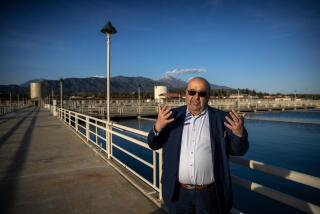Not going with the flow
AT the end of the movie “Chinatown,” after clueless private eye Jake Gittes has doggedly run down all the false leads about water and power in Los Angeles, his partner pulls him back from Evelyn Mulwray’s bullet-shattered face as gawking Chinese bystanders crowd around, and sums up the story’s essence with the despairing line: “Forget it, Jake. It’s Chinatown.”
Robert Towne’s noir fable of murder, greed, incest and hydrology insists that we are only along for the ride in a city full of ugly enigmas. “Beyond Chinatown,” Steven P. Erie’s brisk history of the rise of Southern California’s empire of water, the Metropolitan Water District, won’t supplant the movie version’s stylish nihilism. As a character in the movie might have reminded him, there’s no percentage in remembering anything in L.A.
Erie’s persuasive argument that the Metropolitan Water District is one of the creative but flawed designers of Southern California is haunted by forgetfulness: We forget where our water comes from (less than you might think from the tragic Owens Valley). We forget who manages it for us and why water policy is still the most important political decision we never get to make.
“Beyond Chinatown” is Erie’s second in a projected trilogy chronicling the making of Southern California through its titanic infrastructure. The first, “Globalizing L.A.,” examined the history of -- and the economic power wielded by -- the ports of Los Angeles and Long Beach. In the third, he plans to tackle the contentious history of the Los Angeles Department of Water and Power and the Owens River deal. In this book, he captures the imperial reach of the Metropolitan Water District with its network of big abstractions in concrete and steel that seems to have been here forever and to have an inner life that is, as Erie quotes one critic, “alien, unmanageable, unfathomable, untrustworthy.”
“Met,” as it’s called by intimates and enemies alike, has been all of these things during its 78-year history as it became the ultimate provider of water for the 20 million of us who live at the faucet end of pipelines tapping the Colorado River and the rivers of Northern California. The district, as Erie sees it, is salesman, architect, destroyer and jealous custodian. It exploits and it conserves.
Met also is a specialized regional government run by an appointed board of 37 directors, most of whom you’ve never heard of. It is driven by internal politics -- in fact, it was designed to manage the competing interests of its 26 member water agencies and cities stretching from Santa Barbara to the Mexican border. But it is immune from normal elections and referendums and measures itself only by its vision, as if this mid-20th century assemblage of technicians, bureaucrats, politicians, old-time water-system operators and all their ambitions added up to the creative will (historian Mike Davis calls it a “Bismarckian will”) of a single master builder.
It was through this model of public ownership and corporate stewardship -- of exclusive management of inclusive infrastructure -- that Southern California willed itself into existence in the years after World War I. The Met is the model’s consummate success. Between 1928 and 1941, the district dug and blasted into existence some of the greatest public works in history, wrested water from rivers hundreds of miles away, and poured what it had taken on the slightly dusty house lots of postwar suburbs from Oxnard to San Diego.
Met’s remarkable network was heroic to the ordinary people who voted for its creation and watched how it grew their towns and businesses, Erie writes. Then, either for reasons of organizational efficiency or to maximize development (as their critics say), the old “water buffaloes” of the district remained largely invisible until it began pulling itself apart in the 1990s because rebellious directors from San Diego County feared their dependence on the district’s water and Met’s implicit control of the county’s further growth.
Met endured that turmoil but faces even more trouble now. For reasons of pride and recent legislative prodding, the district must give current and future customers “100 percent assurance that retail-level demands can be satisfied under all foreseeable hydrologic conditions.” Shorn of jargon, that’s a politically necessary promise to fill your tub, crockpot and water glass regardless of global warming, drought, the draining of the Colorado by new Arizona and Nevada boomtowns or the anticipated arrival of at least 6 million additional Southern Californians by 2025. And none of them will have a clue about the sources of their water or how water is managed -- the real Chinatown-like aspect of living here.
But they will be using water differently than you and I have. Once Met merely imported water from other places out of sight and mind. Water was extracted, transported, used and flushed away. The district had built “hard” infrastructure and was largely exempt from questioning about the nexus between water and growth until the 1980s.
Increasingly, Met is having to build the “soft” way -- and recognize the need for “sustainable development that incorporates environmental quality goals and also the equitable protection of weaker localities and future generations against spoliation of their right to water.”
But whose rights will be protected? Mexican villagers along the California border have seen the Colorado River run dry because of unrealistic allocations of water to Met and other claimants. Mexican farmers have seen their fields chemically burned by water tainted with the urban runoff and agribusiness sludge that the river carries most of the time. Southern Californians at least will have the water we want, Erie suggests, if Met follows the “soft path” of increased conservation, waste-water reuse, novel forms of water storage and the idling of California farms to transfer their water allotments to cities.
So is Met’s glass half full or half empty? Erie would say half full, based on his confidence in the dynamism he sees in the agency’s unique management structure. But keeping the water flowing to millions of end users, Erie says, will require Met to remind “the public -- and itself -- of its distinct advantages as a public agency
Unfortunately, forgetting is what we’re best at. It helps explain why we can’t move beyond the myths of “Chinatown” without stories about Los Angeles as reasoned and convincing as Erie’s. *
More to Read
Sign up for our Book Club newsletter
Get the latest news, events and more from the Los Angeles Times Book Club, and help us get L.A. reading and talking.
You may occasionally receive promotional content from the Los Angeles Times.








